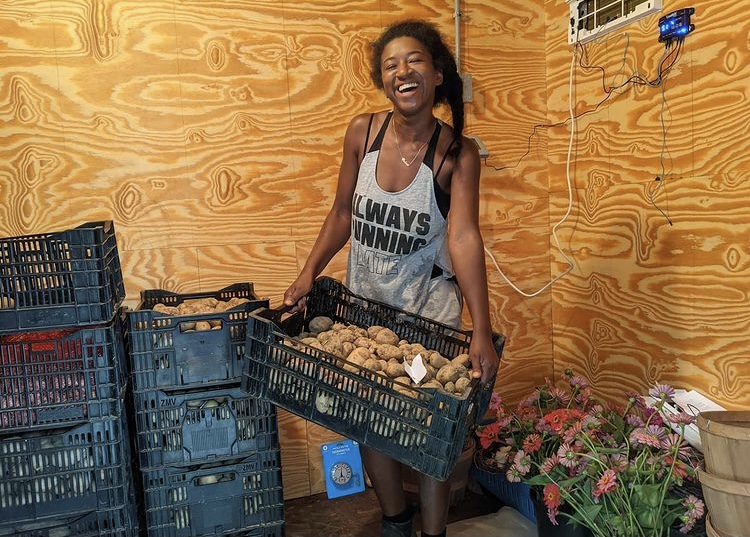GAPs Certification for Produce Growers
go.ncsu.edu/readext?834764
en Español / em Português
El inglés es el idioma de control de esta página. En la medida en que haya algún conflicto entre la traducción al inglés y la traducción, el inglés prevalece.
Al hacer clic en el enlace de traducción se activa un servicio de traducción gratuito para convertir la página al español. Al igual que con cualquier traducción por Internet, la conversión no es sensible al contexto y puede que no traduzca el texto en su significado original. NC State Extension no garantiza la exactitud del texto traducido. Por favor, tenga en cuenta que algunas aplicaciones y/o servicios pueden no funcionar como se espera cuando se traducen.
Português
Inglês é o idioma de controle desta página. Na medida que haja algum conflito entre o texto original em Inglês e a tradução, o Inglês prevalece.
Ao clicar no link de tradução, um serviço gratuito de tradução será ativado para converter a página para o Português. Como em qualquer tradução pela internet, a conversão não é sensivel ao contexto e pode não ocorrer a tradução para o significado orginal. O serviço de Extensão da Carolina do Norte (NC State Extension) não garante a exatidão do texto traduzido. Por favor, observe que algumas funções ou serviços podem não funcionar como esperado após a tradução.
English
English is the controlling language of this page. To the extent there is any conflict between the English text and the translation, English controls.
Clicking on the translation link activates a free translation service to convert the page to Spanish. As with any Internet translation, the conversion is not context-sensitive and may not translate the text to its original meaning. NC State Extension does not guarantee the accuracy of the translated text. Please note that some applications and/or services may not function as expected when translated.
Collapse ▲GAPs is an acronym for Good Agricultural Practices, which in this context is a voluntary certification program related to food safety practices for produce growers.
Regardless of whether a produce grower chooses to obtain GAP certification, it would be foolish and irresponsible not to work towards implementing the covered food safety practices. There are numerous instances of foodborne illness outbreaks that can be traced to fresh produce, in some cases leading to serious long-term health consequences or deaths among those who ate the affected product. The source farms have sometimes been subjected to severe economic losses, and even criminal penalties.
There are various reasons a produce grower may want to undergo this voluntary certification, namely:
- It is a requirement for certain buyers or markets, including many wholesale and institutional buyers
- It can be used as a marketing tool, demonstrating a grower’s commitment to food safety
- It is a helpful tool to organize and document food safety practices
- It could help lay the groundwork for compliance with the Produce Safety Rule of the Food Safety Modernization Act
The cost of certification is the responsibility of the producer, although there may be cost-share funds available to help. For details, check with your local Agricultural Extension agent, or with the N.C. Department of Agriculture and Consumer Services.
Although many of the practices stipulated by GAPs Certification will impact the entire operation, the certification applies to a specific crop or crops, and is valid for one year.
Certification Process
- Attend a produce food safety training program (this is a one-time requirement).
- Identify which auditing system your buyer or potential buyer requires. The auditing system you select may influence implementation of certain practices, recordkeeping, etc.
- Develop and document a food safety plan that complies with the standards of your auditing system, and which covers all the areas listed below.
- Keep records throughout the year of all the actions you take related to your food safety plan.
- Conduct a mock recall exercise.
- Undergo an on-farm audit conducted by a representative of the auditing system you chose. Depending on the auditor, this may need to be scheduled months in advance. Normally the audit will take place during a harvest activity of the product(s) in question.
- Review the results of the audit (whether pass or fail) to see where improvements can be made in your plan, practices, and recordkeeping.
Record-Keeping Topics
- Land
- Worker health and hygiene
- Restrooms and sewage
- Water
- Animals
- Manure
- Equipment and containers
- Traceability
How to Get Started
Interested farmers should start by looking into learning and support opportunities, and reviewing a food safety plan template to get more familiar with the components. These resources may help:
- Training
- For classes offered by the NC State Extension Fresh Produce Safety team visit their website.
- Online training videos and downloadable resource manuals are available from the Carolina Farm Stewardship Association.
- Technical assistance
- Individualized advice may be available from the local Agricultural Extension agent. Find the contact information for each county
- Consulting is available from the Carolina Farm Stewardship Association. Details are available on their website.
- Food safety plan
Food safety is a necessary priority for all farmers. GAP Certification is a tool that helps farmers convey to buyers that they are prioritizing food safety. N.C. Cooperative Extension is here to help farmers navigate this process.



